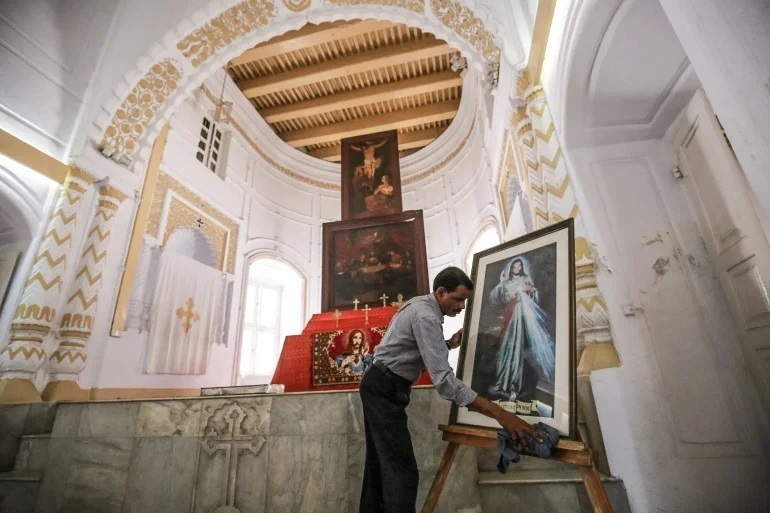
Dhaka– With no priest to minister and no faithful to pray, an Armenian church in Bangladesh has one last parishioner: a Hindu caretaker doing his “sacred duty” to preserve a relic of the city’s former commercial elite.
Shankar Ghosh makes the sign of the cross before opening the entrance of the striking white and yellow edifice, built 240 years ago in the capital Dhaka.
Back then the city was home to hundreds of Armenians, a diaspora that traced its roots in the Muslim-majority nation back to the 16th century and eventually rose to become prominent traders, lawyers and public officials.
The last known descendant of this community left Bangladesh several years ago — but not before entrusting the Armenian Apostolic Church of the Holy Resurrection to Ghosh, who had already lived within its grounds for half of his life.
“I love this work. I consider it a sacred duty bestowed upon me,” the 61-year-old told AFP.
“Whether it is a church, temple or mosque, I believe all are for one God.”
Four decades ago, Ghosh worked at a jute factory — an industry pioneered by Armenians in the region — where he struck up a friendship with the family running it.
Through them, he met church custodian Michael Joseph Martin, who invited Ghosh to be his assistant.
The young man moved into the church compound in 1985 and never left.
“It is a home of God and I thought no other work would better suit me,” Ghosh said.
His 30-year-old son was born in the compound and acts as its resident historian.
When Martin moved to Canada in 2014, he handed his protege the keys to the church.
Ghosh became full-time custodian after Martin died last year at the age of 89, and is now supported by overseas Armenians — led by Los Angeles-based businessman Armen Arslanian — who keep the church running.
“The Ghosh family has a special place in our church,” Arslanian told AFP.
– ‘This beautiful place’ –
Ghosh is drawn to tranquility of the grounds in the heart of the capital’s Armanitola neighbourhood, which was named for the city’s Armenian community.
Narrow and congested roads, flanked by residential blocks and wholesale markets, lay just beyond the compound.
But within the grounds, the cacophony of traffic horns fade away and birdsong rises from a small garden.
Young couples and students gather under the garden’s trees, sharing private moments in the shade.
Each morning, Ghosh emerges from the compound where he lives with his wife and two children to open the church doors and light candles on the altar.
He utters a non-denominational prayer for 400 Armenians — once prominent members of Dhaka and now buried under neat rows of tombstones next to the building.
Several assistants help him maintain the church and feed the half a dozen stray dogs living in the grounds.
Baptisms and weekly mass haven’t been held in the church for several decades.
But the church comes to life every Easter and Christmas, when a Catholic priest holds services attended by ambassadors stationed in Dhaka.
Ghosh often strolls around the tombstones — the earliest dating back to 1714, decades before the church was built.
Laying a flower on the grave of Martin’s late wife Veronica — the last Armenian to be buried in the compound, in 2005 — Ghosh hopes her husband’s remains are brought back to Dhaka.
“He belongs here in this beautiful place,” he said, adding that he too hoped to be buried in the grounds after his death.
“I only pray that I’ll get similar treatment to what I have been providing to these (graves).”
Follow this link to join our WhatsApp group: Join Now
Be Part of Quality Journalism |
Quality journalism takes a lot of time, money and hard work to produce and despite all the hardships we still do it. Our reporters and editors are working overtime in Kashmir and beyond to cover what you care about, break big stories, and expose injustices that can change lives. Today more people are reading Kashmir Observer than ever, but only a handful are paying while advertising revenues are falling fast. |
| ACT NOW |
| MONTHLY | Rs 100 | |
| YEARLY | Rs 1000 | |
| LIFETIME | Rs 10000 | |










